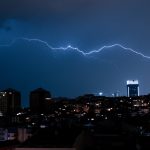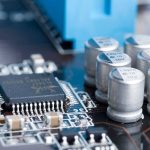The choice and positioning of lightning capture devices requires a specific study of each site, the objective being to ensure that the lighting will preferably “fall” at one of the predefined points (lightning conductors) and not some other part of the building.
There are various methods for doing this, depending on the type of capture device (lightning conductor) and national work practices (see IEC 62305).
One of these, called the “electro geometric model” (or imaginary sphere model) method, defines the spherical volume that is theoretically protected by a lightning conductor according to the intensity of the discharge current of the first arc.
 Figure 7 – General principle of the electrogeometric model
Figure 7 – General principle of the electrogeometric model
The higher this current, the higher the probability of capture and the wider the protected area.
The tip of the leader stroke (or precursor) is deemed to represent the center of an imaginary sphere, with a radius D. This sphere follows the random path of the leader stroke.
The first element to come into contact with this sphere will determine the point at which the lightning will strike: a tree, a roof, the ground or a lightning conductor, if there is one. Beyond the points of tangency of this sphere, protection is no longer provided by the lightning conductor.
The theoretical radius (D) of the sphere is defined by the relationship: D = 10 × I2/3, where D is in metres and I is in kA.
Table 1 – Theoretical radius (D) of the sphere and lightning current values
| D (m) | 15 | 29 | 46 | 96 | 135 | 215 |
| I (kA) | 2 | 5 | 10 | 30 | 50 | 100 |
For optimum protection incorporating the probable lowest lightning current values (protection level I), a 20 m (I = 2.8 kA) sphere must be considered.
Protection levels (IEC 62305)
The model must be adapted according to the type of protection device (single rod lightning conductor, meshed cage, earthing wires) and structure to be protected.
Standard IEC 62305 defines protection volumes according to four protection levels based on the probability of capture:
Table 2 – Protection volumes according to four protection levels
| Level | I | II | II | IV |
| Probability of capture (%) | 99 | 97 | 91 | 84 |
| Min. capture current (kA) | 3 | 5 | 10 | 16 |
| Max. sparkover distance (m) | 20 | 30 | 45 | 60 |


